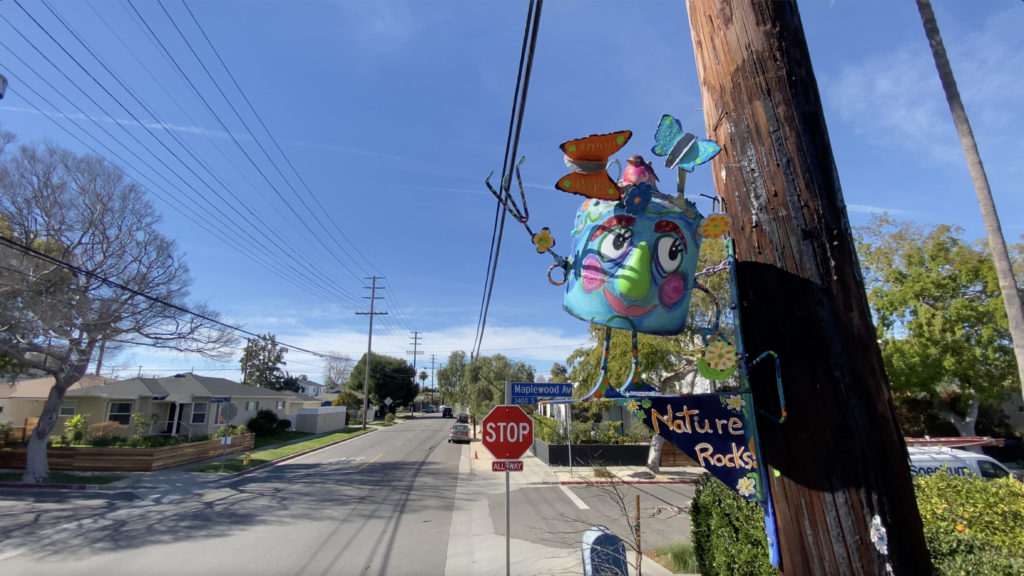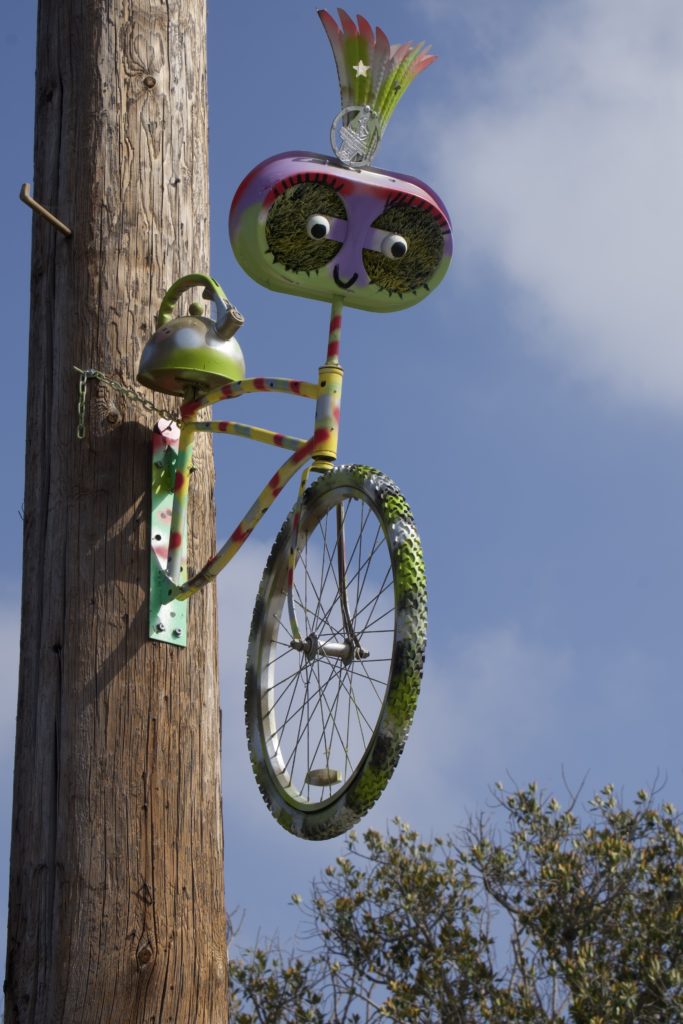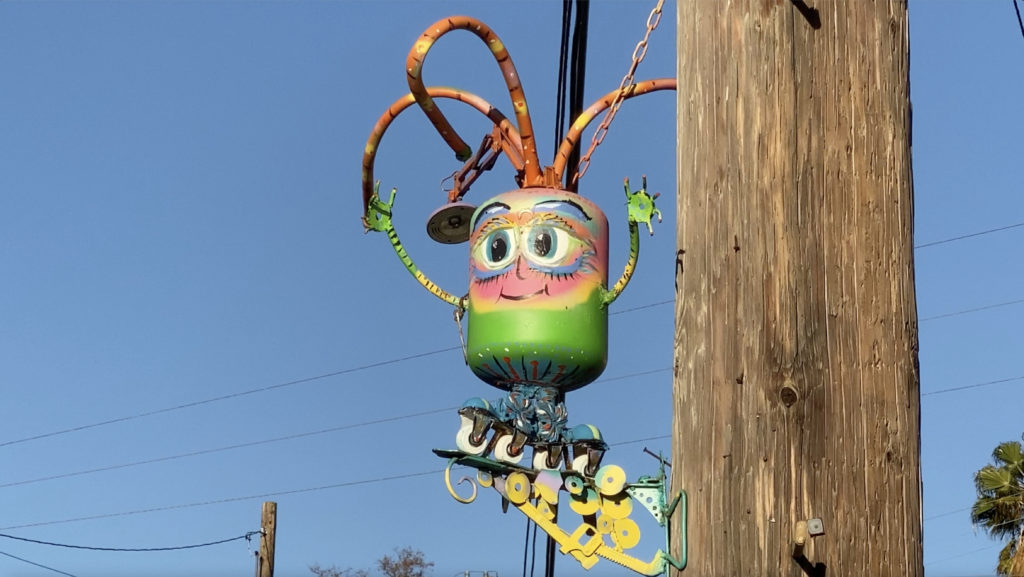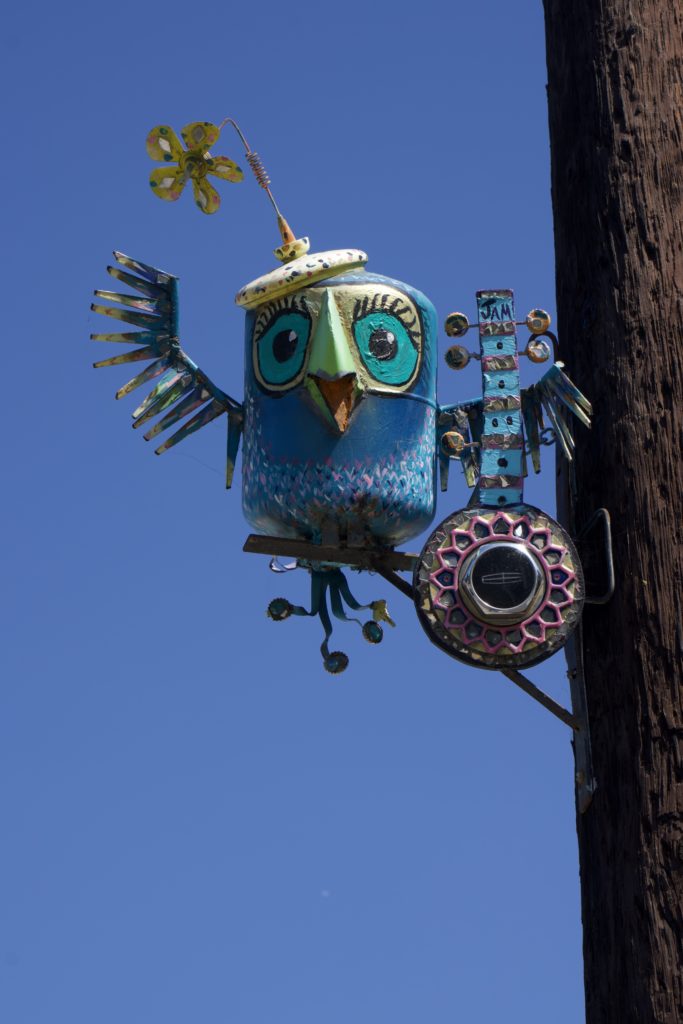 Photo Essay
Photo Essay
Where Gentrification Meets Joyful Resistance (Photo Essay)
Paul Von Blum / Truthdig December 13, 2022 Lori Powers and the public art tradition in Los Angeles. 9 photos-

This work on a busy corner stands next to a popular neighborhood market, which itself has featured a few attractive murals on its sides for the past few years. But the market also rents space to advertisers. In this photograph, the work is juxtaposed with an ad for Los Angeles Apparel. The ad is plainly sexist, placing a female body in an alluring position, her hand on her breast and her hips raised in an obvious sexual way. This is like thousands of others, a repulsive phenomenon regularly condemned in critical literature and in classrooms throughout the world. Drivers and pedestrians see both the sculpture and the ad. One is joyous and the other is repressive. That contrast could (but often probably doesn’t) raise some valuable questions. Neither visual product likely had such an objective, but visual culture nevertheless can accomplish such a result quite independent of artistic intention.
-

This image is actually a partial view of her front lawn, which is illustrative of Lori Powers’ overall artistic vision and accomplishment. It stands out dramatically on her block and adds a vibrant and colorful dimension to the entire Mar Vista neighborhood. I pass it frequently on my daily runs, again tuning my frowns from the encroaching gentrification to smiles on my way back home. The major detail here is a figure driving a car, a charming construction that seems to suggest “Forward!”— a message of exuberance that is almost impossible to ignore. It has become a “must-see” neighborhood attraction.
-

Like many of her public efforts, this work combines found objects with small but notable verbal messages. Small butterflies stand atop a brightly painted can along with “Nature Rocks.” Tellingly, the smile seems only modest. Perceptive viewers might notice a stop sign nearby on the street in front of the telephone pole. Taken all together, it offers a critique, perhaps unintentional, that we must stop environmental degradation, stop letting butterflies and other species disappear, as well as all the other dangers of a perilous planet.
-

Evoking a dramatic surprise, this work features part of a bicycle and a kettle hanging from a telephone pole on a busy corner. This sight must be jarring the first time anyone sees it. Bikes are meant for the road, not for displays on a pole. But at least from my personal reactions, I soon found great enjoyment from seeing the bike on the pole, especially with its pair of eyes peering downward upon the spectators. The kettle, too, is disconcerting, so out of place in its outdoor public setting. This viewer disorientation can provide a catalyst for thought and reflection (and joy) when people mostly go about their business in hurried and often stressful ways.
-

This work highlights a sculptural entity riding a skateboard. In Los Angeles, this is a ubiquitous form of transportation that even transcends conventional age expectations, from teens to middle-agers to seniors. But seeing a skateboard on a telephone pole evokes both astonishment and amusement. Once again, Lori Powers has created a colorful figure with peering eyes. Perhaps suggesting that the skateboard, like other forms of non-fossil fuel transportation, might be a valuable alternative to the auto obsessed culture of Los Angeles and much of the nation.
-

Likewise, Lori’s complex, vividly painted “creature” with horn-like protuberances growing from the head while riding an inline skate also reflects her powerful artistic imagination and evokes similar viewer responses. A closer look also reveals that the work is more artistically complex. Moreover, its colors appear to resemble a rainbow, at least partially. Whether intentional or not, these colors represent the LGBTQ movement. The figure’s appealing smile and its welcoming arms augment that vision. Skating toward liberation is a valuable and clearly progressive goal in the early 21st century.
-

Musical instruments abound in Lori Powers’ public sculptures. These works also join a long history of visual artworks that feature musical themes as subject matter. Like her other works, what distinguishes these is their public nature and their easy accessibility to anyone who pauses for a moment or two to look at them and enjoy. Here, the colorful owl, the banjo and the pinwheel all combine to resonate with residents and visitors alike. Frequently, when the wind blows, the pinwheel revolves, providing viewers with a childlike sense of pleasure. Many of her other works in the Mar Vista neighborhood also have “mini-windmills,” one of her characteristic details. Finally, the wise owl suggests that learning and playing a banjo is truly a challenging task, like making serious and accessible art itself.
-

Some of these whimsical constructions are simply personal favorites; as I noted, they are entirely subjective. This work is mounted on the telephone pole directly across the street from my house. I see it every day, many times over. It provides numerous smiles, in a world that generates all too many frowns, on multiple levels. The owl looks down upon me sternly, its artificial projections almost enveloping me as I walk to my car or even pick up my daily newspaper. Perhaps it’s suggesting that I lighten up: good advice, although often difficult to follow. It appears to admonish me for whatever reason. But far from causing discouragement, it gives me pause. And that, too, is a major function of art: to engage its audience, in whatever personal ways it can. Art is a collaboration, an exchange, a powerful mode of communication. It can help people discover their own creative impulses.